The 10 Best Go-Kart Racing Engines in 2022
Go-Kart racing is a hobby like none other! For some it is the first step towards competitive racing, others just want to have some fun that they will remember for the rest of their life. Whatever goal you have with karting, you need the best engine.
Let’s get one thing out of the way, the best racing engine will depend on your specific situation. There is no one best for everyone. There are several things to take into consideration, such as your geographic location, the tracks you’ll be driving on, your age, and your aspirations.
The most important thing to consider is, whether or not your local karting club/track/chamionship allows for a specific engine. The last thing you want to do is spend $1000+ on an engine that has no races for you to participate in. Going to your local tracks and getting info about the engine classes for different ages is the first thing you should do.
For this list, we’ve taken into consideration the popularity of the engine along with its performance. The engines are arranged from low to high performance. Except for #1, for which we have chosen LO206 just because it’s the best engine to start with.
Here are the best Go-Kart Racing Engines:
- LO206 – 4-stroke 200cc
- Comer 50cc – 50cc for Kids Kart (5 to 7 year olds)
- Mini Rok – 60cc Engine for Cadet Karts (7 to 12)
- Swift Mini – 60cc for Cadet Karts
- IAME KA100 – 100cc Engine for Teens and Adults
- ROK VLR – 100cc Engine for Teens and Adults
- IAME X30 – 125cc TaG Engine
- Rok GP – 125cc TaG Engine
- Rok Shifter – 125cc Shifter Engine
- TM KZ-R1 – 125cc for KZ Class
1. Briggs & Stratton LO206
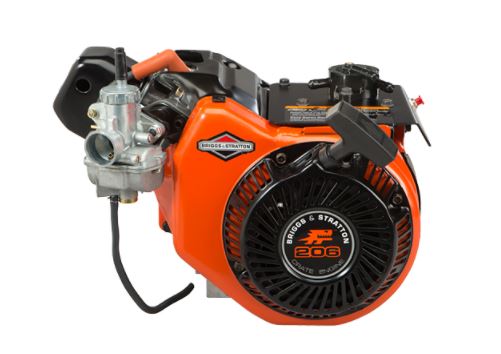
Specs & Features
Type: Single Cylinder, 4-Stroke
Displacement: 204cc
Max Power: 8.8 hp
Max Torque: 10 ft-lbs
Max RPM: 6100
Top Speed: ~60 mph
Engine Cooling: Air Cooled
Price: $600-800
We have picked LO206 as the best engine on this list because we expect a lot of people reading this article to be new to go-kart racing, and there is no better class to start than in Briggs & Stratton Local Option 206. Having this engine as your first will help you develop good driving habits, that will come in handy as you move to faster karts.
The best thing about this engine is that they are super cheap to purchase and maintain in comparison to 2-stroke engines, also they have a class in almost every track in the US that too for every age group (except 5 to 7-year-olds).
Unlike most other racing engines, this is a 4 stroke engine with a large displacement (204cc). However, larger displacement does not mean they are the fastest though. 2-stroke and 4-stroke engines are very different and even if LO206 has nearly double the displacement of 100cc 2-stroke engines, it is still slower than them.
Since this is a 4-stroke engine, Fuel and Oil go in separately and the oil will require changing much more frequently in comparison to 2-stroke engines but on the positive side, you won’t have to deal with the fuel-oil ratio.
Just like most other racing go-karts, LO206 utilized a centrifugal clutch to transfer power from the engine to the axle.
Modifications can be made to the engine but make sure to be within the rule or else you might get disqualified from races. It’s best that any modifications are made with the guidance of an expert from your local track.
2. Comer 50cc
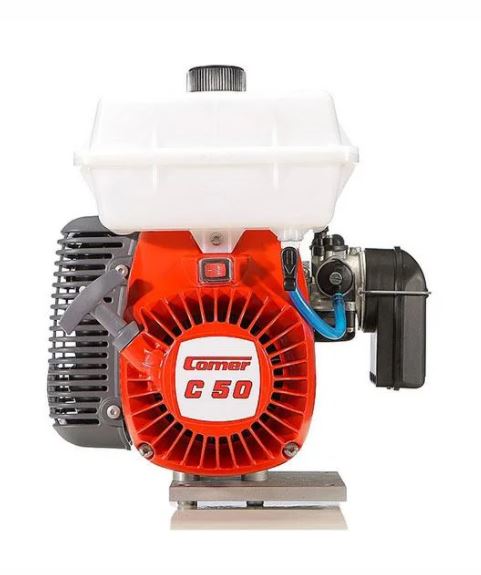
Specs & Features
Type: Single Cylinder, 2-Stroke
Displacement: 50cc
Max Power: 2 hp
Top Speed: ~35 mph
Engine Cooling: Air Cooled
Price: $900-1000
The best time to get into a sport is between 5-8 years of age. The same is true with go-karting, but at the same time we cannot power a 5-year old’s kart with a powerful engine, they have a separate kart (~1/2 the size of an Adult’s kart) that require a smaller engine.
Comer C-50 is the best engine for kid karts class. Most tracks will accept this engine or a 50cc honda engine (contact your local track to know which one they allow). C-50 is a 50 cc engine that produces 2 hp of power and 30-35 mph top speed.
Just like others, this engine utilizes a chain drive system to transfer power to the axle with help of a centrifugal clutch.
The engine will require very little to no maintenance, they come with a sealed crankcase. You’ll just need to change the oil after regular intervals (oil to fuel ratio for the engine is – 25:1).
3. Vortex – Mini ROK
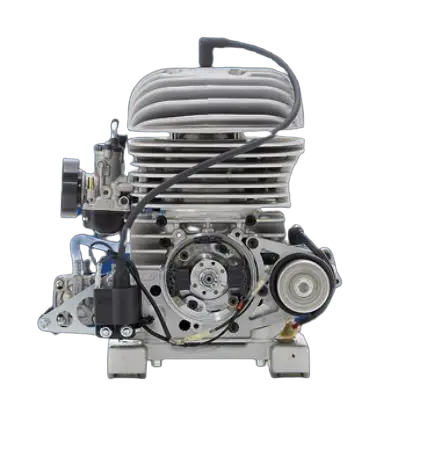
Specs & Features
Type: Single Cylinder, 2-Stroke
Displacement: 60cc
Max Power: 10 hp
Max Torque: 4.79 ft-lb
Max RPM: 15000
Top Speed: ~55 mph
Engine Cooling: Air Cooled
Price: $1600
Mini ROK is a 60cc engine made for cadet class which is a very popular class for kids of ages 7-12. This will be a big upgrade from the 50cc engine, as the kids grow from the playful age of 5-7, karting isn’t just for fun anymore, cadet class are a lot more competitive.
This engine is allowed in almost all tracks that allow cadet kart racing, it is built by Vortex, a very popular kart engine manufacturer from Italy.
The engine is a 2-stroke engine, the fuel-oil mixture recommended is 33.3:1. The mixture can be changed depending on several factors, it’s best to contact an expert from your local track before making any modifications to the fuel or the engine.
In its stock condition, the engine will produce 10 hp power and 15000 rpm. A cadet kart with this engine can go as fast as 55 mph!
Maintenance required will be much more frequent than a kid karts. The carburetor and exhaust needs to be cleaned after every few uses. At this age, you should start teaching the kids about engine maintainance. It’s an important lesson for every young driver.
4. IAME Mini-Swift

Specs & Features
Type: Single Cylinder, 2-Stroke
Displacement: 60cc
Max Power: 10 hp
Max Torque: 5.16 ft-lb
Max RPM: 14000
Top Speed: ~55 mph
Engine Cooling: Air Cooled
Price: $1800
A very similar engine to Mini ROK. Made by another Italian engine manufacturer, IAME. They have been around for a long time and are the largest kart engines manufacturer.
There isn’t much difference between this and Vortex’s 60cc engine, both are electric start, made for cadet karts, and give very similar performance. The best way to choose between them is to choose the one which is popular on your local track.
5. IAME KA100
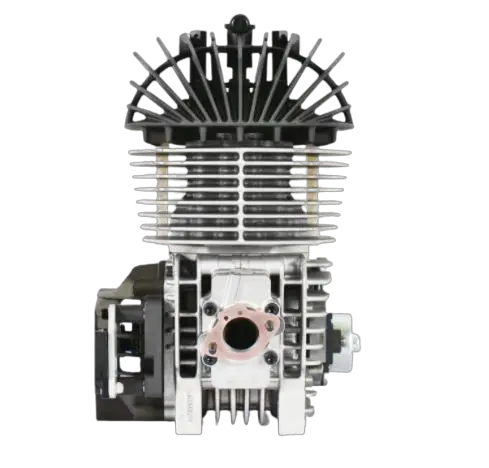
Specs & Features
Type: Single Cylinder, 2-Stroke
Displacement: 100cc
Max Power: 22 hp
Max Torque: 15 ft-lb
Top Speed: ~70 mph
Engine Cooling: Air Cooled
Price: $2800
IAME’s 100cc KA100 is probably the second most popular engine in US after B&S LO206. It is used for the 13-16 age class and the 16+ (Adult) Class. It is seen as a step up from LO206 and is used by racers who aren’t quite ready for the 125cc engine but want more power and speed than LO206.
Nearly every track in US has a class for KA100 so you won’t have to worry about not being able to race with this engine. KA100 is at least 10 mph faster than LO206 and is 2-stroke as opposed to LO206 which is a 4-stroke engine.
But they also cost $1500-2000 more than LO206, and their maintenance won’t be cheap either, something to consider before you make the switch. Some racers even start with KA100 instead of LO206, which is doable, but it is better to start with the 4-stroke LO206 just because of how cheap they are in comparison.
6. ROK VLR

Specs & Features
Type: Single Cylinder, 2-Stroke
Displacement: 100cc
Max Power: 20 hp
Max Torque: 10.12 ft-lb
Top Speed: ~68 mph
Engine Cooling: Air Cooled
Price: $2100
A cheaper competitor to KA100 from Vortex. It is slightly less powerful for the adult class, but for junior class, Vortex’s engine is faster due to the restriction on KA100. Some series are running both of these two engines in the same class.
It’s hard to beat KA100 due to their low maintenance requirement. But Vortex makes a very good engine, if your local track allows this engine and it fits your budget, there is no reason to not consider this.
7. IAME X30
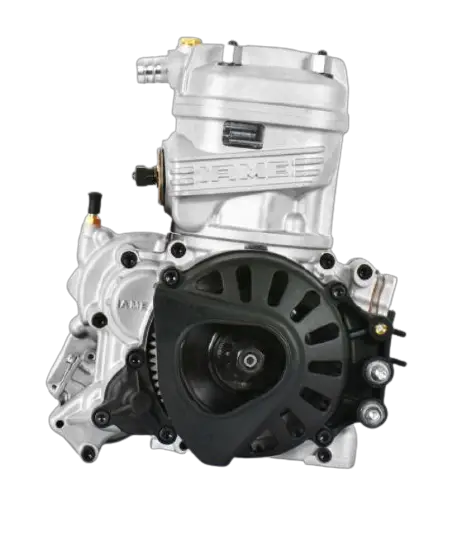
Specs & Features
Type: Single Cylinder, 2-Stroke
Displacement: 125cc
Max Power: 30 hp
Max Torque: 14.3 ft-lb
Top Speed: ~75 mph
Engine Cooling: Water Cooled
Price: $3300
The 125cc engine class in Go-kart racing is the most popular all over the world. 125cc engines can be further divided into TaG and shifters, shifter karts being the ones with a manual transmission while TaG utilizes automatic centrifugal clutch.
X30 is the most popular 125cc engine in the TaG class, it uses a centrifugal clutch and an electric start. The top speed of a kart with a 125cc X30 is around 75 mph, but the engine can be restricted to a slower speed.
X30 model also has a more powerful 175cc engine, but it would be very hard to find any race where you can participate with those. There is also an X30 shifter engine, that you can look into.
This engine along with other 125cc engines are water-cooled as opposed to the air-cooled engines up to 100cc. 125cc engines are also much more complex than 100cc engines. Their maintainance will cost you more than a 100cc.
Since it is made by IAME, it is one of the most reliable engines you can find. You won’t require any rebuild for at least 20 hours on this engine.
Note: Don’t buy 125cc Engines if you’re a beginner.
8. Rok GP

Specs & Features
Type: Single Cylinder, 2-Stroke
Displacement: 125cc
Max Power: 36 hp
Max Torque: 14.8 ft-lb
Top Speed: ~78 mph
Engine Cooling: Water Cooled
Price: $3100
Vortex’s 125cc TaG class engine, which is a strong competitor of X30. This would be a better engine than X30 on a track with fewer turns. The top-end power and speed for this engine are better than the X30, but X30 has better low-end torque.
Another thing to consider while choosing between this and X30 is the parts availability, parts of X30 are easily available due to their popularity.
Apart from that, they are pretty similar engines in terms of performance. The best thing to do is check what is more popular in your region and go with the most popular one.
9. ROK Shifter
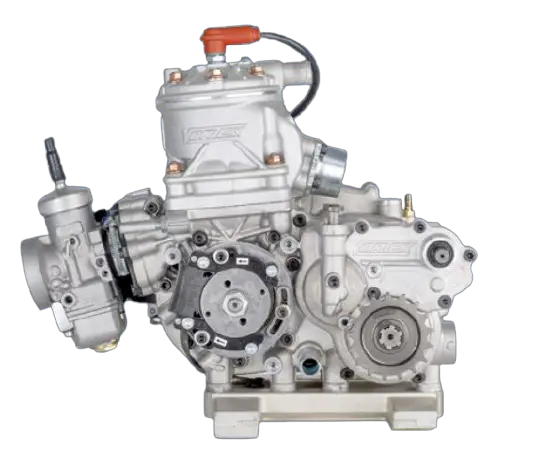
Specs & Features
Type: Single Cylinder, 2-Stroke
Displacement: 125cc
Max Power: 43 hp
Top Speed: ~85 mph
Engine Cooling: Water Cooled
Price: $4000
Now we can finally talk about some shifters! We have choosen ROK Shifter from Vortex as the best shifter you can buy. However, the most popular 125cc shifter in US is the Honda CR-125 engine.
ROK Shifters have a gear box with 6 forward gears. Uses an oval exhaust and 2 boosters and a 30mm carburetor (better than CR-125). It can produce up to 43 hp power! The top speed of a kart with these engine can be 85-90 mph.
As mentioned above, Honda CR-125 are the most popular shifter karts used in tracks all around US. If you’re in Europe, ROK and other IAME shifters are more popular.
If we compare this engine to Honda, this is a clear winner for top end performance. However, Honda engines are much easier to maintain.
The piston of ROK shifter engine will require being swapped every 8-10 hours of use, the clutches will also need to be looked after, also you should be good with gear changes if you want the engine to last for long time. Honda on the other hand will hold itself well even if you’re lazy with maintainance.
10. TM KZ-R1

Specs & Features
Type: Single Cylinder, 2-Stroke
Displacement: 125cc
Max Power: ~48 hp
Top Speed: ~95 mph
Engine Cooling: Water Cooled
Price: $5000
TM KZ-R1 is an engine for KZ class. This class was formaly known as Formula C. This class is the fastest you go before entering Superkarts class. KZ-R1 is made by TM Racing, which is yet another Italian company, known for their racing engines.
KZ karts are extremely powerful and very fast but that also means they require a lot of maintainance. You can expect about 10-15 hours of usage from piston before you need replacing. Keeping a KZ engine maintained can be heavy on your pockets. Keep that in mind before you make purchase, it’s not a one tme cost.
Buyer’s Guide
If you’re a beginner and living in US, the best engines to start on are LO206 and KA100. Both are extremely popular and will almost certainly have a class for every age group (except kid karts). If you can manage to borrow these 2 engines, you can try them both out to know which class you preffer.
Once you start to get better and want to go faster, then you can move to the 125cc engines, which itself can be divided into 2 categories. Shifter and TaG. Shifter karts are very expensive to maintain.
That brings us to the next point, Maintainance cost. Racing engines are epensive themselves, but maintainance costs should also be considered during purchase. Generally, the more powerful an engine is, the more it will cost to maintain.
